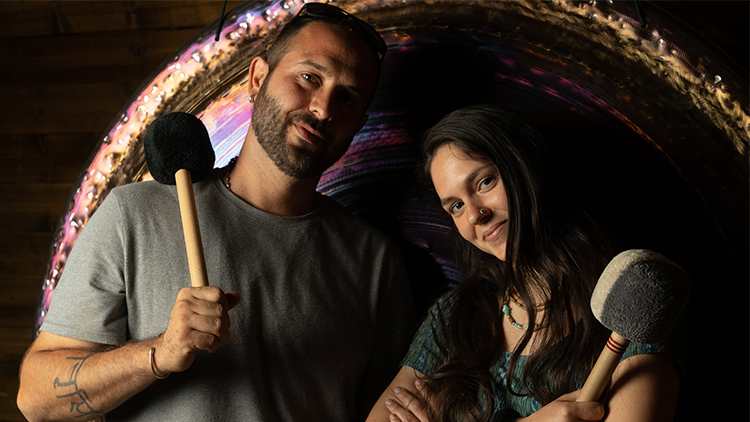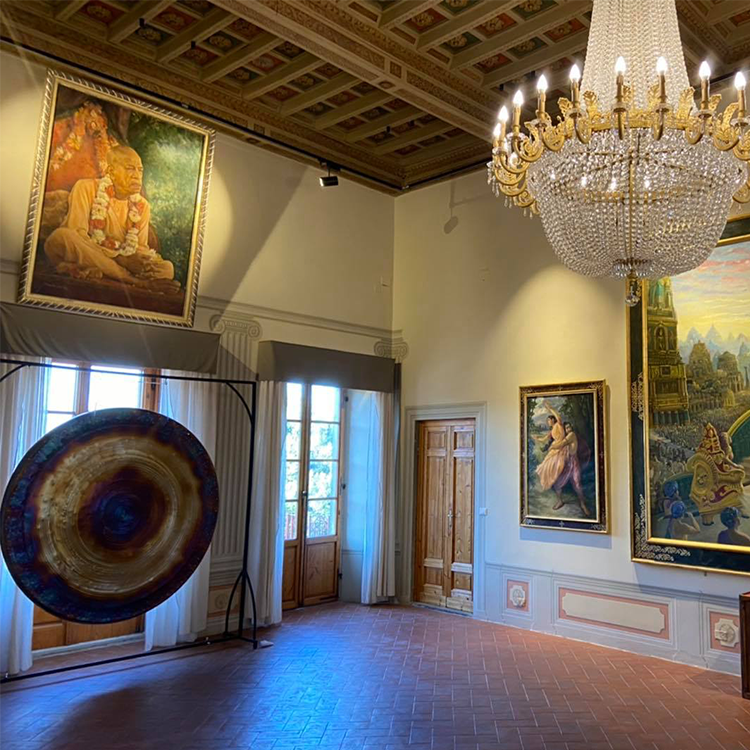Couple Creates Unique Sound Path for Italy’s Museum of Sacred Art
By Madhava Smullen | Oct 09, 2020

An Italian devotee couple has created and installed a permanent “sound path” at the Museum of Sacred Art (MOSA) in Villa Vrindavana, near the city of Florence, home of the Italian renaissance. The installation was created by Madhava and Margherita at their Grotta Sonora, or “The Sounding Cave.”
Consisting of unique handmade gongs and other instruments, called “sound sculptures,” the sound path makes tours of MOSA an auditory as well as a visual experience. Different sounds in each room create different moods and provide a soundtrack to the Mahabharata and Ramayana paintings by Jnananjana Das and other ISKCON artists, as the tour guide narrates the story of the ancient epics.
Members of the public can now have the experience at Villa Vrindavana’s MOSA, which is open with COVID restrictions in place every Saturday and Sunday from 10:30am to 1:00pm, and from 3:00pm to 6:00pm. The project is part of a vision by Mahaprabhu Das, International Director of MOSA (which also has branches in Belgium and Tenerife), to create a full sensory experience which will soon include an olfactory component too.

The giant 80 inch gong in the Ramayana Hall
It’s been an interesting journey to this point for sound path creators Madhava and Margherita, who both grew up in the countryside near Rome. The two met while busking, and Madhava, who grew up as a devotee, introduced Margherita to Krishna consciousness. They then began collecting a variety of musical instruments from all over the world and building their own using unconventional materials such as PVC and recycled metals.
About fifteen years ago, it all began to come together when Mukundananda Das, Madhava’s father, bought and renovated an ancient Etruscan cave in Calcata, a small medieval village overlooking the Treja Valley, about forty kilometers from Rome.
In August 2016, the cave opened to the public as “Grotta Sonora,” “The Sounding Cave.” Originally intended to be a preaching center, it features an altar with a beautiful murti of Lord Krishna right at the entrance – “ideologically, for us, Krishna is the real owner of the cave,” Madhava says. The turquoise floor is painted to look like a river flowing into all four rooms, which are actually four connected caves, representing the flow of sound.

Lord Krishna altar in the Sounding Cave
Throughout the cave are between fifteen and twenty different one-of-a-kind instruments, made from wood and various alloys, with more being invented all the time. There’s a leaf-shaped steel cello; a harp gong; a giant singing bowl that one sits inside while it’s played; and a “vimana” inspired by the ancient aircraft of the Ramayana, created from a metal sheet which the player holds, plays with a violin bow and bends to modulate the sound.
The many different-sized gongs and singing bowls often incorporate wind chimes, strings and other features. They come in shimmering gold and rainbow colors, are inscribed with yantras and other designs, and are made in different shapes to play with resonance, thus earning them the moniker “sound sculptures.” Each one is handmade and has a different look and sound, placing them in high demand.
Prior to COVID-19, Madhava and Margherita would conduct sound baths for groups of people at their cave, using their instruments and chanting of mantras for relaxation, meditation, and therapeutic healing.

The Leaf cello and 60 inch gong. Between them is the turquoise ‘river’ flowing down the steps and through the cave, representing the flow of sound
Since the beginning, they have also created instruments and sold them online for customers to do their own therapy at home, as well as for resellers all over the world; this work has continued throughout the pandemic.
“People are attracted because the sound is Krishna’s energy, although they don’t know it,” says Madhava.
Commissioned by MOSA Director Mahaprabhu Das to help realize his vision for a full sensory experience, Madhava and Margherita took six months to produce the instruments for MOSA Italy, ensuring their high standard of quality. They also trained tour guides at Villa Vrindavana to play the instruments to accompany their tour narration.
According to MOSA Italy General Manager Tom Scharre, guests and guides at the museum wear masks, maintain a distance of one meter, and disinfect their hands, while each tour is limited to a maximum of ten persons. Only tour guides play the instruments, and all touched surfaces are disinfected afterwards.

Sound sculptures in the Hero’s room
Around eight sound sculptures are installed throughout MOSA Italy, between the first floor, which features Mahabharata paintings by Italian artist Jnananjana Das, and the second floor, with Ramayana paintings by US artists Ram Das and Dhriti Dasi, as well as Jnananjana and Sacidananda Das from Vrindavana, India.
Madhava and Margherita’s beautiful golden leaf-shaped steel cello takes its place in the Mahabharata section, in front of a giant painting of Lord Krishna entering Dwaraka. Next to a beautiful painting of the sun god Surya visiting Kunti Devi is a gong that makes a sweet sitar sound to match the image’s mood.
On the second floor is a massive eighty-inch gong, set between two paintings of the Ramayana war and next to a wooden sculpture of the fearsome demon Kumbhakarna. Dubbed “The Kumbhakarna Gong,” it produces a powerful, deep sound to make guests feel like they are in the middle of the conflict, as do other gongs matched with the Mahabharata’s Kuruskhetra war.

The Leaf and sitting bowl in the City Room
Among the other instruments are a thirty-four inch gong inscribed with a Sri Yantra, a stringed singing bowl that makes a tampura-like sound, and a huge fifty-inch singing bowl. One person per tour will get the unique opportunity to sit inside this bowl while the tour guide plays it, thus experiencing the vibrations throughout their body; the bowl is sanitized after every use.
The Hare Krishna maha-mantra and other mantras are also incorporated into the sound path experience.
“I feel excited about this addition, because I think that music is something that really touches people on a deeper level,” says museum manager Tom Scharre. “Our movement and our whole philosophy has quite a big focus on music and sound. So this is a great extra feature, and we’ve had very good feedback so far from the people who have experienced it.”

The Sri Yantra gong
Looking to the future, essential oils will be added to every room in the museum to add an olfactory element to the experience.
For their part, Madhava and Margherita hope to eventually help create similar sound paths for other MOSA branches around the world too. They see this, and all their work, as service.
“It’s very clear that Krishna’s energy, through sound, is so powerful,” Madhava says.















